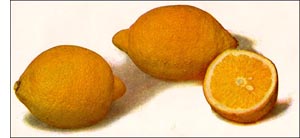Lemon fruit
 The Lemon is the fruit of a small tree from ten to fifteen feet high. It is not particularly beautiful, being rather shrubby in its appearance.
The Lemon is the fruit of a small tree from ten to fifteen feet high. It is not particularly beautiful, being rather shrubby in its appearance. It is an evergreen, bearing leaves, flowers, and fruit all the year round. The flowers occur singly in the axils of the leaves. The calyx is persistent, that is, it does not drop off like the corolla, and may be found attached to the base of the fruit. The corolla consists of five spreading petals of a purplish-pink color.
The lemons of the market are from cultivated plants, of which there are a large number of varieties. These cultivated varieties or forms took their origin from the wild lemon trees native in northern India, in the mountain forests of the southern Himalayas, in Kumoan, and Sikkim.
As the result of cultivation there are now about fifty varieties of lemons in existence. Some of these are comparatively sweet, or rather insipid, and are therefore, known as sweet lemons. The sour varieties are, however, more generally cultivated.
As above stated, the lemon tree bears fruit all the year round, so that a number of crops are gathered annually. There are, however, three principal crops collected, as follows: The first, from July to the middle of September; the second, in November, and the third, in January. Frequently there are also collections in April and in May.
The tree is rather delicate; not as hardy as the orange, for example. In upper Italy it even becomes necessary to cover the trees during the winter months. Lemons intended for shipment are picked before they are fully ripe and packed in barrels or boxes holding from four to seven hundred. When exposed the fruit shrinks and loses in weight very rapidly, due to the evaporation of moisture from the pulpy interior.
Originally a native of Asia, the Lemon has become widely distributed in Europe, Africa, and America, and, although far more susceptible to injury from frosts than the orange, the trees are successfully cultivated under many conditions.
Doubtless the best results in this country have been obtained in California. Thousands of acres around San Diego are planted with lemon trees, while large districts in the Ojai Valley, Ventura, Santa Barbara, Pomona, and Los Angeles counties are devoted to its cultivation. The tree is remarkable for beauty, and, while it seldom attains large proportions, its pale green leaves, loosely hanging branches, showy and fragrant flowers, together with the fruit that is found in all stages of development, produce a pleasing and highly ornamental effect. While the best crop of lemons is generally gathered between December and April, the fruit should be picked every month for ten months of the year, in order to retain the best results.
As a rule, the trees yield from one hundred and twenty-five to one hundred and forty boxes of the fruit to the acre, about the sixth year, but this number is increased to four hundred boxes when the groves reach an age of ten years.
The varieties of lemons are distinguished chiefly by their size and form, and may be roughly classified as egg-shaped with blunt nipples and oblong lemons with large nipples. The sweet lemon and thin-rind Poncine and Naples belong to the first class, while the second includes such forms as the imperial, the Gaeta, and the wax. The principal varieties grown in California are the Lisbon, Eureka, and the VillaFranca. Of these, the Eureka originated in California, while the Villa-Franca was imported from Europe. Besides the grateful quality of the juice, the expressed oil of the rind is used in the arts and has an intense odor of lemon.
Lemon picture